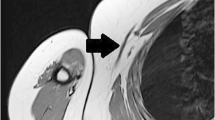Abstract
Purpose
This unique case gives the extent of knowledge in the axilla area with axillary arch (AA) and a discussion of its clinical importance.
Materials and method
The anatomical anomaly was found during the dissection class for the brachial plexus. It was identified through the precise dissection of the structures bilaterally.
Results
The cadaver had fascial and muscular AA bilaterally. The fascial AA was separated into the superficial and deep arch group. The superficial arch group connected to the clavipectoral fascia and the axillary fascia. The deep arch group attached to the subscapular fascia. The muscular AA had superficial and deep variations. The superficial muscular AA attached between accessory slip of latissimus dorsi muscle (LDa) and pectoralis quartus muscle (PQ). The deep muscular AA attached to the crest of lesser tubercle of the humerus from LDa. The adipose tissue with the level one central lymph node was located lateral to the pectoralis minor muscle expand from pectoral lymph node through between LDa and PQ.
Conclusion
This case showed the fascial and muscular AA together. The muscular AA had both complete and incomplete attachment types. It could give functional and neurological problems in the axilla, such as thoracic outlet syndrome. Additionally, the structures presented with the axillary lymph node. It helps to understand the patient’s condition with the AA in the axilla and could provide.





Similar content being viewed by others
References
Aziz MA (1980) Anatomical defects in a case of trisomy 13 with a D/D translocation. Teratology 22:217–227
Bharambe VK, Arole V (2013) The axillary arch muscle (Langer’s muscle): Clinical importance. Med J DY Patil Univ. 6(3):327–330
Bonastre V, Rodrίguez-Niedenfȕhr M, Choi D, Sañudo JR (2002) Coexistence of a pectoralis quartus muscle and an unusual axillary arch: case report and review. Clin Anat 15(5):366–370
Chunder R, Guha R (2014) Bilateral muscular axillary arch: an anatomic study and clinical considerations. J College Med Sci-Nepal 10(3):56–60
Cihak R (1972) Ontogenesis of the skeleton and intrinsic muscles of the human hand and foot. Adv Anat Embryol Cell Biol 46:5–194
Daniels IR, Della Rovere GQ (2000) The axillary arch of Langer-the most common muscular variation in the axilla. Breast Cancer Res Treat 59:77–80
Grim M (1972) Development of the primordia of the latissimus dorsi muscle of the chicken. Folia Morphol 19(3):252–258
Georgiev GP, Jelev L, Surchev L (2007) Axillary arch in Bulgarian population: clinical significance of the arches. Clin Anat 20:286–291
Haninec P, Tomás R, Kaiser R, Cihák R (2009) Development and clinical significance of the musculus dorsoepitrochlearis in men. Clin Anat 22:481–488
Jelev L, Georgiev GP, Surchev L (2007) Axillary arch in human: common morphology and variety. Definition of “clinical” axillary arch and its classification. Ann Anat. 189(5):473–481
Loukas M, Noordeh N, Tubbs RS, Jordan R (2009) Variation of the axillary arch muscle with multiple insertions. Singapore Med J 50(2):e88–e90
Merida-Velasco JR, Rodriguez Vasquez JF, Merida Velasco JA, Sobrado Perez J, Jimenez Collado J (2003) Axillary arch: potential cause of neurovascular compression syndrome. Clin Anat 16:514–519
Habib Rahbar, Partridge SC, Javid SH, Lehman Constance D (2012) Imaging axillary lymph nodes in patients with newly diagnosed breast cancer. Curr Probl Diagn Radiol 41(5):149–158
Ramsay A (1812) Account of usual conformations of some muscles and vessels. Edinb Med Surg J. 8:281–283
Smith R, Cummings JP (2006) The axillary arch: anatomy and suggested clinical manifestations. J Orth Sports phy Therapy 36(6):425–429
Standing S (2008) Pectoral girdle and Upper limb in Gray’s Anatomy. 40th ed. In: Borley NR, Healy JC, Collins P, Johnson D, Crossman AR, Mahadevan V, Editors. Spain: Churchill Livingstone, Elsevier p. 777–906
Testut L (1884) Les anomalies musculaires chez l’homme expliquées par l’ Anatomie comparée et leur importance en Anthropologie. Masson, Paris, pp 107–117
Turgut HB, Peker T, Gülekon N, Anil A, Karaköse M (2005) Axillopectoral muscle (Langer’s muscle). Clin Anat 18:220–223
Deniz Uzmansel, Alev Kara, Zeliha Kurtoglu (2011) Unusual axillary arch and accompanying musculofascial variations: case report. Turkiye Klinikleri J Med Sci. 31(4):1011–1014
Uzmansel D, Kurtoḡlu Z, Kara A, Ӧztűrk C (2010) Frequency, anatomical properties and innervation of axillary arch and its relation to the brachial plexus in human fetuses. Surg Radiol Anat 32:859–863
Acknowledgements
The author kindly thanks Dr. John Romfh, Mrs. Jo Anne Romfh, for advisement and review of English, and Martin Rice (the Dean of the school of health sciences at Indiana Wesleyan University), for English corrections and supporting the research.
Author information
Authors and Affiliations
Contributions
The author contributed to the study conception and design. Material preparation, data collection, visualizations, and analysis were performed by P-WK. The first draft of the manuscript was written by P-WK and the author modified on the previous versions of the manuscript. Martin Rice gave the corrections in English and suggested better descriptions. The author read and approved the final manuscript.
Corresponding author
Ethics declarations
Conflict of interest
The author declare that they are no conflicts of interest.
Additional information
Publisher's Note
Springer Nature remains neutral with regard to jurisdictional claims in published maps and institutional affiliations.
Electronic supplementary material
Rights and permissions
About this article
Cite this article
Kim, PW. Variations of the musculofascial axillary arch with the adjacent lymph nodes. Surg Radiol Anat 43, 27–32 (2021). https://doi.org/10.1007/s00276-020-02544-1
Received:
Accepted:
Published:
Issue Date:
DOI: https://doi.org/10.1007/s00276-020-02544-1





